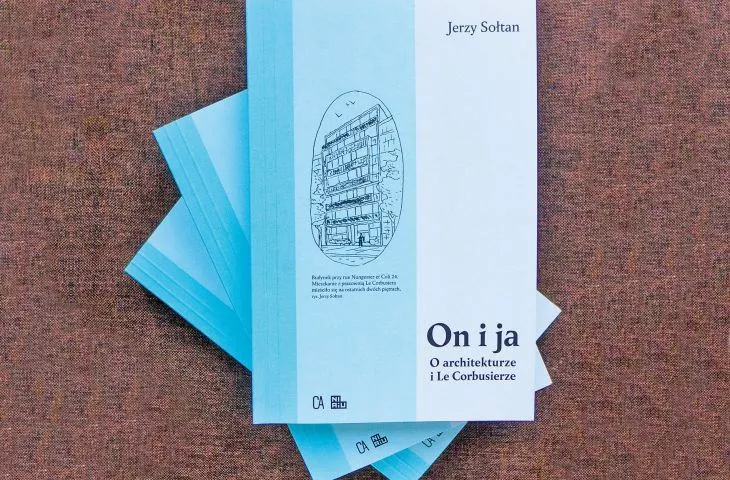We present an excerpt from Jerzy Soltan's book "He and I. On Architecture and Le Corbusier," which was published in 2020 by the Center for Architecture and the National Institute of Architecture and Urbanism.
The building at 24 rue Nungesser et Coli. The apartment with Le Corbusier's studio was located on the top two floors,
drawing by Jerzy Soltan
24 rue Nungesser et Coli
(JS meets LC)
At four in the afternoon of July 31, 1945, I ring the doorbell of Le Corbusier's apartment, which also serves as his personal studio. So I am not in his office in the center of Paris, but in the Boulogne district, in the Molitor building at 24 rue Nungesser et Coli.
The whole place exudes tranquility. It's a beautiful, quiet, sunny afternoon, though far from Paris, France, times are still dramatic. The war with Germany is barely over, the Soviets are settling in Berlin, the war with Japan is still going on. I only arrived in Paris today, after five years in a POW camp, five years out of touch with "reality." I still wear the camp rags and am terrified - of life and of this Le Corbusier I am about to meet. I press the bell, wait.
Finally, the sound of clamor. The door opens. It is Le Corbusier in the flesh, with heavy glasses set in the ultra-heavy frames so fashionable later among architects, looking out from behind them with tired eyes. His gray hair is combed back and neatly slicked to his skull. He is wearing a plain American wool shirt with a black and white checkered pattern and old, soft homemade flip-flops. He looks at me wearily, at the very center of my figure, then measures me with his eyes from the top of my head to the floor. He is 5 feet 8 inches tall - 173 centimeters. Me - 6 feet 2.5 inches [189 centimeters]. He doesn't look impressed. Finally, he greets me: "Tiens, c'est Soltan, mais vous êtes trop grand" [A, that's Soltan, but you are too tall]. There is a moment of silence, followed by an outstretched hand and a hug. We look at each other. I'm taken aback. What does all this mean? What to do with such a greeting? Not very nice, is it?
I am recreating this moment in detail not for the sake of historical pedantry. These words and gestures, as I was to find out later, had significant meaning. "You're too tall," meant, of course, that I was too tall in relation to the calculations that consumed him at the time. I was, or rather am, clearly too tall relative to the anthropometric data he wanted to use in the new system of measurements common to the entire industrialized world. At 6 feet and 2.5 inches tall, I was messing up the already established order based on 5 feet and 8 inches [173 centimeters]. The welcoming remark exposed, in the very first moment of the meeting, his tendency to obsess.
After this welcoming ceremony, I am invited inside, deep into the apartment, or rather penthouse, occupying the top two floors of the building. On the lower level I meet the spouse, Madame Yvonne Le Corbusier, for her husband Von or Vonne. I meet another, also important household member, a very brown and very friendly dog, a schnauzer with the appropriate name Pinceau, or Brush (his pedigree can be found in the collections of the Le Corbusier Foundation).
Speaking of names, the employees always addressed the boss as "monsieur Le Corbusier." No chumminess! Among ourselves, we called him "Corbu" - a nickname he liked and used to apply to himself. LC related it to the French word "corbeau" - raven. "Corbu" and "corbeau" were so related to him that he made the symbol of the bird his personal seal, an emblem placed next to and sometimes even instead of his signature. The rather contemptuous nickname Monsieur Le Cornemusier, a play on the word cornemuseur - "bagpiper" - was also known in École des Beaux-Arts circles. I will return to the surname Jeanneret or Jeanneret-Gris and the origins of the entire family from La-Chaux-de-Fonds in the Swiss Jura and their supposed connections to the French Albigensians or Cathars later.
At this hour, the apartment is filled with sunshine. Large glass windows let in the power of light and an expansive view. The view of Mont Valérien with the outline of the fort shivering in the summer heat far on the horizon gives the interior a special mood. The studio apartment surprises me with its character. Having only a modest experience of Eastern European modernism - Polish, German, Czechoslovakian - I expected something similar or even stronger: smoothness and rigidity, furniture made of chrome tubes, angular, totally abstract painting. That's seemingly what it is here, and yet not quite.
On the walls I see, naturally, some contemporary paintings - purist works by Le Corbusier and Ozenfant next to some racy Cubist canvases. In the corner of the dining room stands a sculpture by Jacques Lipchitz. Yet the mood of the house is created by a large painting hanging above the table - by André Bauchant, one of the "naïve" or "primitives," a visual cousin of Rousseau's Customs. In form, however, Bauchant is much more delicate than his famous "relative." He took his theme from classical mythology: a tranquil, idyllic scene with gods and goddesses harmoniously arranged among the clouds, contrasting sharply with the sharpness and brutality of Purism and Cubism.
The basic furnishings also exude a gentleness extremely different from the shiny, mechanical precision of metallic, tubular modernism. Instead of metal tubes - bent wood in the familiar Thonet style. Finally, in the workshop itself, the main wall contrasts with the soft, neutral white of the others. Le Corbusier left it in raw, unplastered stone - an early manifestation of what was later called Brutalism. For me, accustomed to the shiny, smooth uniformity of Modernism's plastic tricks, based on affinities and similarities, this bold use of contrast between the precision of the new and the soft coziness, or rather timelessness, of the old is a revelation. It's like comparing Mies van der Rohe's exhibition pavilion in Barcelona with Corbusier's 1937 Paris pavilion.
On the higher level of the apartment, these contrasts play an even greater role. The entire space, partly built-up and partly open, is full of vegetation. A huge variety of herbs have found refuge here. Plants fill every crevice in the concrete, wild and disheveled, some tall, others low. The flowering ones attract insects, especially bees, peacefully buzzing around. The exuberance of the blossoms means not only colors, but also smells and even sounds - it's hard to ignore here the effect that the buzzing of insects had on the atmosphere of the apartment. It is here, on the upper level, that I finally stop with LC for a chat and an important decision is made. Starting tomorrow, August 1, I will be accepted into the team. The team? At that moment it was extremely modest. In fact, it was a duo composed of himself and one associate. My arrival was turning the duo into a trio.
Now it would probably be appropriate to tell how I discovered Le Corbusier. I did it on my own in Poland in the library of the school where I studied architecture.1 In my first year, I was certainly not intellectually prepared to grapple with the books and magazines that were there. I simply could not yet decipher technical drawings. But it gave me pleasure to page through these incomprehensible images. I even suspect that often the less I understood what I was seeing, the more it fascinated me: lines, dots, graphic textures... But slowly, gradually, this purely visual interest in the material spawned a curiosity about what was behind it - what it was, where it was, and eventually who did it. In the dull collection of answers to these questions, I gradually began to notice a remarkable constancy and repetition in the answers to the "who" question, and it was a memorable moment when the names Le Corbusier and Pierre Jeanneret appeared in my life. They appeared and perpetuated themselves. They settled permanently in my visual consciousness.
At first it was a purely visual phenomenon for me. I did not capitalize on the true meaning of any of the projects, but the Swiss Pavilion, Maison Loucheur, the La Roche house or the weekend house in Vaucresson effectively enchanted me. I began to grasp the spatial meaning of the drawings much later, until it was time to learn about poetry, closely intertwined with image and reason, expressed in words. The book When Cathedrals Were White2 allowed me to get to know LC as a poetic writer. Its very subtitle - Journey to the Land of Shy People - and the introduction contrasting the present with the era of cathedrals, a time so distant that cathedrals were still new, carried a message whose intellectual meaning and depth I grasped much later. This book set my life's direction and purpose - I knew that at all costs I had to get to know this LC and work with him. I would find, penetrate and get into its orbit. After Chairs, other publications began to fall into my hands. I read them all, I think, and became quite an expert on "corbusierians". Fortunately, I always did well in French. And it happened that a dozen years later, richer by some dramatic experiences, I found myself face to face with Le Corbusier and discussing the future with him. This time "our" future, which was to begin the next day.
-
This is about the Faculty of Architecture at the Warsaw University of Technology, where the author studied from 1931.
-
The book was published in Paris in 1937. Soltan recalled his first contact with Le Corbusier's thought as follows: "The mother of my future wife then offered me a book that sealed my fate, so to speak. Quand les cathédrales étaient blanches - When the cathedrals were white... The book came straight off the press at the time and was the last Corbusier-Parisian novelty. I took it on vacation with a sense of duty, but also with the conviction that it would spoil my summer. But well... the old lady offers, she will ask, examine... It is necessary to read. I remember that I got down to reading with a sense of hurt and compulsion. I began to read... and was immediately captivated by what was offered to me. I fell in love with both the form and the content. I could not afford an in-depth value judgment of what I was reading. However, those values that were available to me, the poeticism of the era, the poeticism of life in general, the perception of values unknown or even new to me, and all this expressed in this peculiar language, full of neologisms... This was actually the source of some fascination. My enthusiasm was expressed by attempts to translate this book into Polish", Rozmowy o architekturze, conversation Andrzej Bulanda, Museum of the Academy of Fine Arts, Warsaw 1996, p. 39. Sołtan's translation of a fragment of the book appeared in the magazine "Arkady" (American Drapers Are Too Small, "Arkady" 1939, no. 6, pp. 256-267). First full Polish edition: Le Corbusier, When Cathedrals Were White. Journey to the country of shy people, transl. Tomasz Swoboda, Centrum Architektury, Warsaw 2013.


























